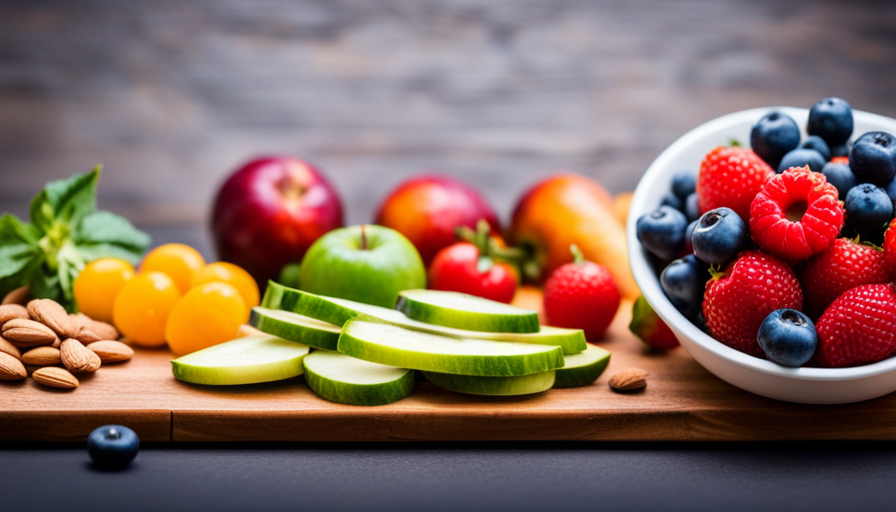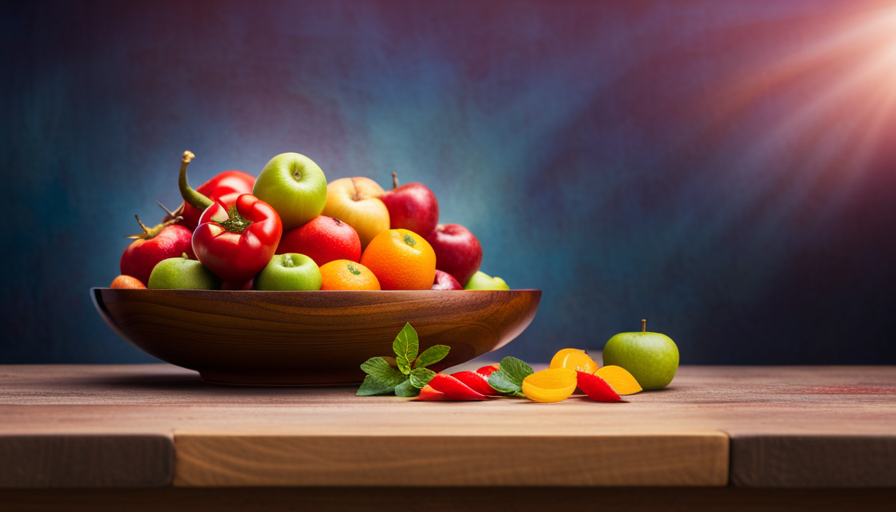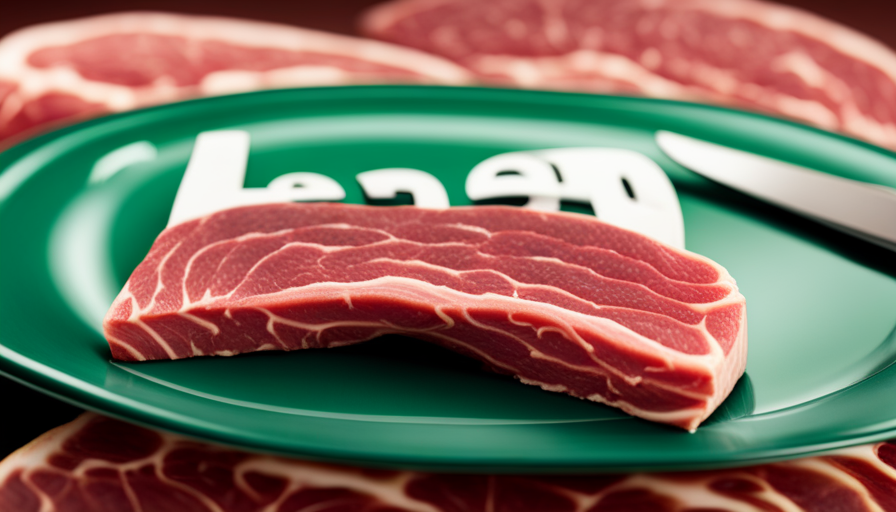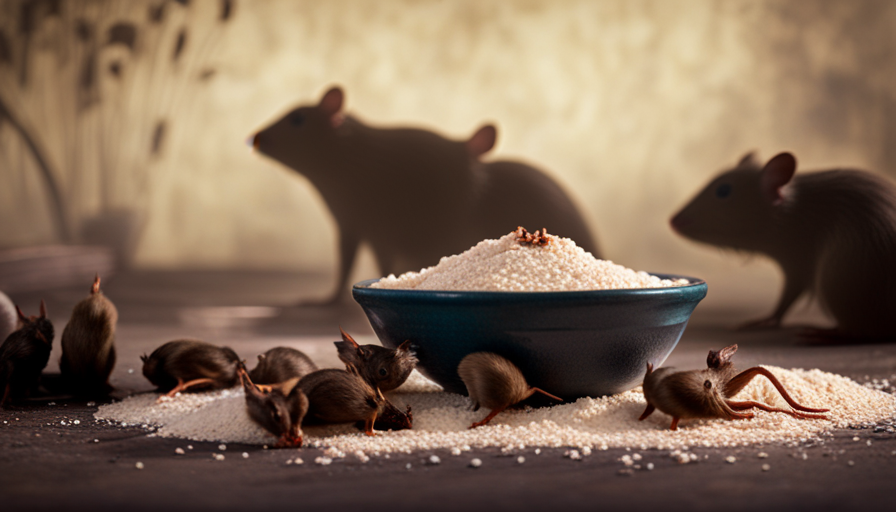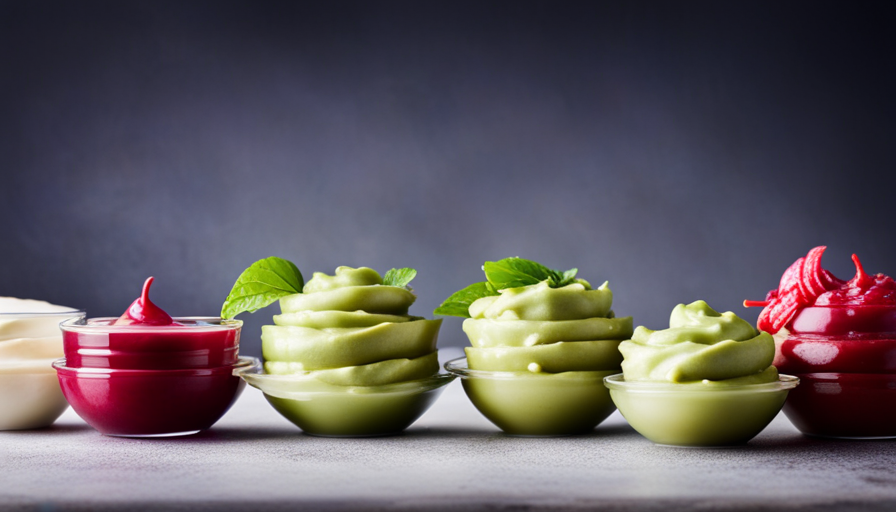Have you heard that adding raw foods to your diet can offer a variety of health advantages? As per research from the American Journal of Clinical Nutrition, a raw food diet may reduce the risk of chronic conditions like heart disease, diabetes, and obesity.
As someone who follows a raw food lifestyle, I have experienced firsthand the positive effects it can have on my overall well-being. In this article, I will share with you what I eat in a day on a raw food diet, from satisfying breakfast ideas to delicious lunch and dinner options.
I will also provide you with snack ideas and discuss the essential nutrients you need to consider when adopting this lifestyle. Additionally, I will offer tips for meal planning and preparation, as well as potential challenges you may face and how to overcome them.
By the end of this article, you will have a better understanding of the raw food diet and be inspired to embrace this nutritious and delicious way of eating.
Key Takeaways
- Raw food diet provides essential nutrients and enzymes, boosting the immune system and improving digestion.
- The high fiber content in raw food aids in weight loss and keeps you feeling fuller for longer.
- Raw fruits and vegetables are packed with vitamins, minerals, and antioxidants, offering the highest level of nutrition and health benefits.
- Meal planning and preparation in advance, as well as finding raw food substitutes, are important for successfully following a raw food diet.
Benefits of the Raw Food Diet
There’s no denying the amazing benefits you can experience from following a raw food diet. Not only does it provide numerous health benefits, but it can also aid in weight loss.
When you consume raw fruits, vegetables, nuts, and seeds, you’re providing your body with a plethora of essential nutrients and enzymes that are often lost during the cooking process. These nutrients help boost your immune system, improve digestion, and increase energy levels.
Additionally, the high fiber content in raw foods can help keep you feeling fuller for longer, reducing the temptation to overeat and aiding in weight loss.
Moreover, raw foods are typically low in calories and high in water content, making them an excellent choice for weight management. By incorporating more raw foods into your diet, you can easily reduce your calorie intake without sacrificing nutrition. Studies have shown that individuals who follow a raw food diet often experience significant weight loss and improvements in body composition.
The raw food diet offers a wide range of health benefits and can also be an effective tool for weight loss. By focusing on consuming whole, unprocessed foods in their natural state, you can optimize your health and achieve your weight loss goals.
Now, let’s delve into the introduction to raw food principles.
Introduction to Raw Food Principles
Discover a whole new way to nourish your body as you embrace the principles of a raw food lifestyle. The raw food diet is based on the belief that uncooked, unprocessed foods provide the highest level of nutrition and health benefits. By eating raw, you’re consuming foods in their most natural state, preserving their enzymes, vitamins, and minerals.
This can lead to improved digestion, increased energy levels, and enhanced overall well-being. One of the main benefits of the raw food diet is the abundance of nutrients it provides. Raw fruits and vegetables are packed with vitamins, minerals, and antioxidants that are essential for optimal health.
Additionally, raw foods are generally low in calories and high in fiber, making them great for weight management and digestive health. Incorporating raw food recipes into your daily routine can be both exciting and delicious. From refreshing salads to zesty raw soups, the possibilities are endless.
You can also experiment with raw desserts, such as raw chocolate mousse or raw fruit tarts, which can satisfy your sweet tooth without compromising your health. Transitioning to a raw food lifestyle doesn’t have to be difficult.
In the next section, we’ll explore some easy and nutritious breakfast ideas that’ll kickstart your day with vitality and nourishment.
Breakfast Ideas
Start your mornings off right with these delicious and nutritious breakfast ideas that’ll give you the energy you need for a productive day.
When it comes to a raw food diet, breakfast can be a great opportunity to fuel your body with nutrients and kickstart your metabolism. There are plenty of raw food breakfast recipes that aren’t only tasty but also provide numerous health benefits.
One popular option is a fruit smoothie bowl. Blend together a variety of fruits like bananas, berries, and mangoes, and top it off with some nuts, seeds, and coconut flakes for added texture and flavor. This refreshing and filling breakfast will provide you with a good dose of vitamins, minerals, and fiber to keep you satisfied until lunchtime.
Another raw breakfast idea is a chia seed pudding. Mix chia seeds with your choice of plant-based milk, such as almond or coconut milk, and let it sit overnight in the fridge. In the morning, you’ll have a creamy and nutritious pudding that can be topped with fresh fruits, nuts, or even some cacao nibs for a chocolatey twist.
Eating a raw breakfast has its benefits. Raw foods are rich in enzymes, which can aid digestion and promote a healthy gut. They’re also packed with vitamins, minerals, and antioxidants, which support overall health and well-being. Additionally, raw breakfasts are often low in calories and high in fiber, making them a great option for weight management.
Now that we’ve covered some delicious raw food breakfast recipes and the benefits of a raw breakfast, let’s move on to exploring lunch and dinner options.
Lunch and Dinner Options
When it comes to lunch and dinner options on a raw food diet, I love to create colorful salads with an array of raw vegetables and greens. Not only are they visually appealing, but they’re also packed with vitamins, minerals, and fiber.
Another favorite of mine is zucchini or cucumber noodles with raw sauces, which are a delicious and healthy alternative to traditional pasta dishes.
Lastly, raw soups and gazpachos are a refreshing option for a light and nourishing meal, especially during the warmer months.
Colorful salads with raw vegetables and greens
Feast your eyes on the vibrant and nutrient-packed salads I devour daily, bursting with colorful raw veggies and refreshing greens. These raw food recipes not only provide a delightful crunch but also offer numerous benefits of eating raw. By consuming vegetables and greens in their natural state, we retain their enzymes, vitamins, and minerals, which can be lost through cooking. This ensures that our bodies receive maximum nutrition.
Additionally, raw salads are rich in fiber, aiding digestion and promoting a healthy gut. They’re also low in calories, making them an excellent choice for weight management.
Now, let’s move on to the next section, where I’ll share my favorite zucchini or cucumber noodles with raw sauces. These light and flavorful dishes are a perfect way to satisfy your cravings while staying true to the raw food diet.
Zucchini or cucumber noodles with raw sauces
Let’s dive into the delicious world of zucchini or cucumber noodles with flavorful raw sauces, so you can indulge in a scrumptious meal while still embracing the health benefits of a plant-based lifestyle.
- When it comes to raw food recipes, zucchini or cucumber noodles are a game-changer. They provide the perfect alternative to traditional pasta, adding a refreshing twist to your meal.
- To make these noodles, you can use a spiralizer or a julienne peeler. It’s quick and easy, giving you a satisfying pasta-like texture without the heaviness.
Now, let’s talk about the sauces. Raw sauces are a great way to enhance the flavors of your zucchini or cucumber noodles. From creamy avocado pesto to tangy tomato marinara, the options are endless.
- These sauces are packed with nutrients and enzymes, as they’re not heated during the preparation process. This ensures that you’re getting the maximum benefits from your raw food.
So, grab your spiralizer, experiment with different sauces, and enjoy a guilt-free meal that’ll leave you feeling nourished and satisfied.
Now, let’s move on to the next section about raw soups and gazpachos to discover more delightful raw food options.
Raw soups and gazpachos
Indulge in the refreshing flavors of raw soups and gazpachos, where vibrant vegetables and aromatic herbs combine to create a tantalizing culinary experience. Raw soups are an excellent way to nourish your body with a wealth of nutrients while enjoying a light and refreshing meal.
These soups are typically made by blending a variety of raw vegetables, such as tomatoes, cucumbers, and bell peppers, along with herbs and spices. Gazpacho, a traditional Spanish cold soup, is a popular choice among raw food enthusiasts. It’s typically made with ripe tomatoes, cucumbers, onions, garlic, and a splash of vinegar. The result is a vibrant and flavorful soup that can be enjoyed as a starter or a main course.
Now, let’s move on to some delicious snack ideas that’ll keep you energized throughout the day.
Snack Ideas
Savor the burst of flavor from a handful of juicy grapes, a refreshing and simple snack idea that’ll leave you feeling refreshed and satisfied.
When it comes to healthy snacking on a raw food diet, there are plenty of options to choose from. Here are three ideas to satisfy your cravings and keep you on track with your raw food journey:
-
Raw Energy Bites: These little bites of goodness are packed with nuts, seeds, and dried fruits. They’re easy to make and perfect for snacking on the go. Plus, they provide a great source of energy to keep you fueled throughout the day.
-
Raw Veggie Sticks with Dips: Crunchy veggies like carrots, celery, and bell peppers make for a satisfying snack when paired with delicious raw dips. Try making a creamy avocado dip or a tangy cashew-based dip to add some extra flavor.
-
Raw Fruit Parfait: If you’re craving something sweet, a raw fruit parfait is the perfect choice. Layer fresh fruits like berries, sliced bananas, and diced mangoes with a dollop of nut butter and some raw granola for a delicious and guilt-free dessert option.
Now that you have some healthy snacking and raw dessert options, let’s move on to hydration and beverage choices.
Hydration and Beverage Choices
Quench your thirst and stay refreshed with a variety of hydrating beverages to complement your healthy lifestyle. Hydration is crucial for overall health and plays a vital role in digestion, circulation, and temperature regulation.
While water is the best option for hydration, there are alternative beverage choices that offer hydration benefits as well. One option is herbal tea, which not only provides hydration but also offers various health benefits. Chamomile tea, for example, has calming properties, while green tea is rich in antioxidants.
Another alternative is coconut water, which is naturally hydrating and packed with electrolytes. It’s a great option for replenishing fluids after a workout or during hot summer days.
If you’re looking for more flavor, you can try infusing water with fruits, herbs, or vegetables. Cucumber, lemon, and mint are popular choices that add a refreshing twist to plain water. Additionally, homemade smoothies made with fresh fruits and vegetables can be a hydrating and nutrient-rich option.
Incorporating these alternative beverage options into your daily routine can not only keep you hydrated but also add variety and flavor to your diet. As we move on to the next section about essential nutrients to consider, it’s important to remember that staying hydrated is just one piece of the puzzle in maintaining a balanced and healthy raw food diet.
Essential Nutrients to Consider
In my previous subtopic, I discussed the importance of staying hydrated and making wise beverage choices while following a raw food diet. Now, let’s shift our focus to essential nutrients to consider when embarking on this dietary journey.
While a raw food diet can offer numerous health benefits, it’s crucial to be mindful of potential nutrient deficiencies. This diet primarily consists of uncooked fruits, vegetables, nuts, and seeds, so certain nutrients may be limited. For example, iron, calcium, vitamin B12, and omega-3 fatty acids are commonly found in animal products, which aren’t typically consumed in a raw food diet.
To address these potential deficiencies, it’s important to incorporate a variety of nutrient-dense foods into your daily meals. Leafy greens like spinach and kale are excellent sources of iron and calcium, while seaweed and chia seeds provide omega-3 fatty acids. Additionally, consider adding nutritional yeast or fortified plant-based milks for vitamin B12.
By being proactive in ensuring a well-rounded intake of essential nutrients, you can thrive on a raw food diet while avoiding potential deficiencies. Moving forward, let’s explore some practical tips for meal planning and preparation to help you succeed on this journey.
Tips for Meal Planning and Preparation
Make sure to carefully plan and organize your meals ahead of time to ensure a successful and enjoyable journey on the path of raw food nutrition. Meal prepping and grocery shopping are two key components of a well-executed raw food diet. By dedicating some time each week to plan your meals and prepare your ingredients, you can set yourself up for success and make the transition to a raw food lifestyle much easier.
When it comes to meal prepping, start by creating a weekly meal plan. This will help you stay on track and ensure that you have all the necessary ingredients on hand. Look for recipes that incorporate a variety of fruits, vegetables, nuts, and seeds to ensure that you’re getting a wide range of nutrients. Once you have your meal plan, make a detailed grocery list and stick to it when you go shopping. This’ll help you avoid impulse buys and ensure that you have everything you need to create your meals.
Once you have your ingredients, take some time to prepare them in advance. Wash and chop your fruits and vegetables, and store them in airtight containers in the fridge. This’ll make it easier to grab and go when you need a quick snack or meal. You can also prepare larger batches of things like smoothies, soups, and salads and store them in the fridge or freezer for later use.
By incorporating meal prepping and grocery shopping into your routine, you can make your raw food journey more manageable and enjoyable. These practices’ll help you stay organized and ensure that you always have nutritious meals and snacks on hand. With careful planning and preparation, you can navigate the potential challenges of a raw food diet and overcome them with ease.
Potential Challenges and How to Overcome Them
Overcoming potential challenges on your raw food journey can be as simple as finding creative ways to incorporate a variety of flavors and textures into your meals. One common challenge that raw food enthusiasts face is cravings for cooked or processed foods. To overcome these cravings, it’s important to find raw food substitutes that satisfy your taste buds. For example, if you’re craving a warm, comforting meal, you can try making a raw zucchini pasta with a delicious homemade marinara sauce made from fresh tomatoes, herbs, and spices. This dish provides the same satisfaction as traditional pasta without the need for cooking or processing.
Another challenge that may arise is finding convenience in a raw food diet. It’s easy to resort to unhealthy processed snacks when you’re on the go or in a rush. To overcome this, it’s helpful to plan and prepare raw snacks in advance. You can create a table with two columns and three rows to visualize different raw snack options that are easy to grab and take with you. Some ideas include raw nuts and seeds, homemade energy bars made from dates and nuts, and sliced fruits and vegetables with a dip like hummus or guacamole.
Embracing a raw food lifestyle may come with its challenges, but with creativity and preparation, they can be overcome. By finding raw food substitutes and planning ahead, you can maintain a nutritious and satisfying diet that supports your health and well-being.
Conclusion: Embracing a Raw Food Lifestyle
Now that we’ve discussed the potential challenges of following a raw food diet and how to overcome them, let’s wrap up by talking about embracing a raw food lifestyle.
Embracing a raw food lifestyle can be a transformative experience. By nourishing your body with whole, unprocessed foods in their natural state, you can reap a multitude of benefits.
One of the key benefits of a raw food diet is the abundance of nutrients it provides. Fruits, vegetables, nuts, and seeds are packed with vitamins, minerals, and antioxidants that can boost your immune system, improve digestion, and promote overall well-being.
Another advantage of a raw food lifestyle is the increased energy levels. Raw foods are easier to digest, allowing your body to efficiently convert them into fuel. This can lead to enhanced vitality and a greater sense of clarity and focus throughout the day.
Additionally, a raw food diet can support weight management. Raw foods tend to be lower in calories and higher in fiber, which can help you feel full and satisfied while maintaining a healthy weight.
Embracing a raw food lifestyle can offer numerous benefits, including improved nutrition, increased energy, and weight management. So why not give it a try and see how it can positively impact your life?
Frequently Asked Questions
Can I still eat cooked food occasionally while following a raw food diet?
Yes, it’s possible to occasionally eat cooked food while following a raw food diet. However, it’s important to note that the primary focus of a raw food diet is consuming uncooked and unprocessed foods. Incorporating cooked food should be done in moderation and with careful consideration. Cooking methods such as steaming or lightly sautéing can help make certain foods easier to digest and increase nutrient availability. However, it’s best to prioritize raw foods to fully reap the benefits of a raw food diet.
How can I ensure I am getting enough protein on a raw food diet?
To ensure I’m getting enough protein on a raw food diet, I focus on incorporating plant-based protein sources into my meals. Foods like nuts, seeds, legumes, and leafy greens are excellent options. These provide essential amino acids for muscle growth and repair.
Additionally, a raw food diet offers numerous benefits such as increased nutrient intake, improved digestion, and enhanced energy levels. So, by choosing the right plant-based proteins, I can thrive while enjoying the advantages of this lifestyle.
Are there any specific foods I should avoid on a raw food diet?
There are certain foods that should be avoided on a raw food diet due to potential health risks. These include raw meat, eggs, and unpasteurized dairy products, as they can contain harmful bacteria.
Additionally, it’s recommended to avoid consuming raw beans and certain nuts, as they may contain toxins that can cause digestive issues.
It’s important to be aware of these foods to ensure a safe and healthy raw food diet.
Can I eat out at restaurants while following a raw food diet?
Yes, it’s possible to eat out at restaurants while following a raw food diet. When dining at fast food restaurants, look for options like salads, fresh fruit cups, or vegetable wraps. Some fancy restaurants may also have raw options on their menu, such as crudité platters or vegetable-based dishes. However, it’s always a good idea to call ahead and ask about their raw food offerings to ensure they can accommodate your dietary needs.
Is it safe for children or pregnant women to follow a raw food diet?
It’s important to consider safety concerns and nutritional requirements when it comes to children and pregnant women following a raw food diet. While there may be potential benefits, such as increased nutrient intake, it’s crucial to ensure that all necessary nutrients are being met.
A balanced approach is key, as a solely raw food diet may not provide enough calories or certain nutrients. Consulting with a healthcare professional is advised to ensure the health and well-being of both the child and the mother.
Can Legumes Be Included in a Raw Food Diet?
Yes, eating legumes on a raw diet is possible. Soaking or sprouting legumes can make them easier to digest. However, some people may still experience digestive discomfort. It’s essential to listen to your body and consult a nutritionist when making significant changes to your diet.
Conclusion
In conclusion, embracing a raw food lifestyle has numerous benefits for our health and well-being. By consuming a diet rich in fruits, vegetables, nuts, and seeds, we provide our bodies with essential nutrients and enzymes that support digestion, improve energy levels, and boost our immune system.
As the saying goes, "You’re what you eat," and choosing to eat raw, whole foods allows us to nourish our bodies with the best nature has to offer.
So let’s start incorporating more raw foods into our daily meals and reap the rewards of a vibrant and thriving life.

